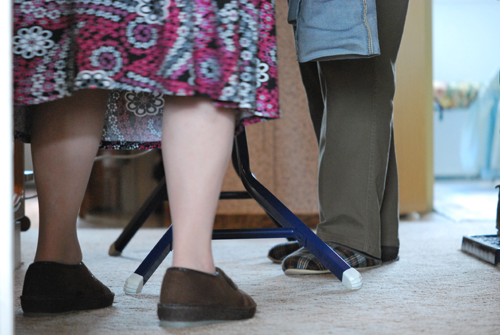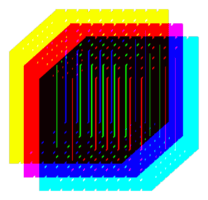Mac Life | Prof. Dr. Buether, is there such a thing as a “psychology of color”?
Axel Buether | As an expert in visual perception and communication, I have been researching the psychological effect of colors on our experience and behavior for many years. The results are much more complex than the generally known color symbols, as the effect of each color changes with the object and context of the perceptual situation. When people decide on the color of a product, they rarely give preference to their favorite color. Customers choose the color that they feel or believe best suits the product. This is why customers around the world most often choose black, white, gray or silver for high-quality technical devices or cars. Achromatic colors support associations such as value, timelessness and sustainability. They make it easier for us to decide to buy expensive products, as they appear high-quality and signal a high resale value due to their independence from fashion trends.
Mac Life | How do you apply these findings to modern product design?
Axel Buether | The right color or color collection makes a decisive contribution to the success of a product, as we are strongly influenced by emotional factors and are primarily guided by visual criteria. Colors have a strong effect on our feelings and instincts, which has biological causes. We intuitively orient ourselves by colors, identify ourselves with colors, use colors to deter or seduce, to control behavior and for social interaction. However, we don’t need to know why we find something beautiful or ugly. It is enough if we sense that we are interested in an object, how strongly we desire or reject it and how we can relate to it. In modern product design and marketing, the focus is increasingly on the experience value, which is why the color or color palette of products, packaging and advertising materials as well as the atmosphere of their presentation are a key factor for success.
Mac Life | The first “personal” or “home” computers didn’t seem to attach much importance to color as a defining element of their design – they were mostly clad in white or beige. A reflection of the purely functional demands of early IT hardware?
Axel Buether | In the early days, these objects were still purely technical in nature and were therefore usually integrated into racks or hidden under tables. Just as little was invested in product design, form and color design in the early IT hardware as in the development of intuitive user interfaces. The user’s perspective played a subordinate role, as many products were unrivaled. Design only becomes an economic factor when there is a variety of products and the business is characterized by competition. This is where color becomes a decisive marketing factor for branding and the creation of an experience value that generates emotionality, identification and desire among customers.
Mac Life | When did the approach to computer and peripheral design change?
Axel Buether | Two drastic changes in the relationship between man and machine are responsible for this. The development and spread of the “personal computer” marked the beginning of the personalization of information technology, which led through several stages to the current smartphone, which shapes the identity of the user. Color and form not only determine the character of the design object on the desks of homes and offices, but also the virtual identity of the individuals on the graphic interfaces of countless users on the World Wide Web. An expression of this change was the colorful appearance of the first iMac generation introduced in 1998, whose semi-translucent housings were given imaginative color names such as “Bondi Blue, Blueberry, Grape, Lime, Strawberry and Tangerine”. Product designer Jonathan Eve was responsible for the harmonious balance between the innovative technology and the avant-garde appearance of the iMac, whose attitude represents the aspirations and success of the “Apple” brand. He does not see color as a fashion attribute, but as an intrinsic part of the overall product, in which everything serves a purpose. This also explains the change in product color, which reflects the success story from self-confident underdog to established premium brand.
The revolution in the function and appearance of computers began with the “Apple Lisa” PC introduced in 1983, which for the first time offered a visual-haptic interface between man and machine with a graphic “desktop” and an object-like “mouse”. In our perception, reality and fiction merge, as we can move into the fictitious space of the program with the help of our eyes and hands in order to orient ourselves and carry out specific actions. Today, the color design of program interfaces is largely carried out by professional designers who implement clear content requirements and at the same time create aesthetic values such as a corporate identity. By personalizing the appearance of desktops, websites and social network profiles, many users today create and design their own virtual living spaces whose content and aesthetics enable identification and identification. Today, the colour preferences of individuals are no longer only reflected in the individualization of clothing, everyday objects and living spaces, but also in the colour design of their digital living environment. This insight determines the modern design thinking process, in which product marketing and product design are an integral part of a customer-oriented world of experience.
Mac Life | Apple was quite colorful right from the start. The first Apple logo shone in the colors of the rainbow. Today the apple is single-colored. Which design of the Apple logo appeals to you more personally – and would Apple actually appear less serious today if they had kept the original?
Axel Buether | From 1977 to 1998, Apple used the “rainbow apple” logo designed by Rob Janoff, which combines two iconographic statements. Since the myths surrounding the expulsion from paradise, the bitten apple has symbolized our quest for knowledge. The spectrum of rainbow colors, on the other hand, refers to the revolutionary full-color graphical user interface, making “user-centered design” the company philosophy. The trendy logo expressed a modern, open and humanistic claim and was addressed to customers who perceived their Apple computer as a way to expand their creative freedom and an expression of a positive, progress-oriented attitude to life. With the commercial success of the Power Macintosh, the appearance of all products changed. The new minimalist design by Jonathan Eve follows the style of German industrial designer Dieter Rams and became an integral part of the brand identity, preventing further experimentation with the color and design language to this day. The decoloration of the Apple logo is just as much a sign of this change of course as the reduction of the product name to Power Mac or the upgrading of the housing with durable materials and high-quality surfaces. From now on, the black, white, gray or translucent shape of the bitten apple expresses the message of a high-quality global premium brand that wants to act independently of short-lived fashions and trends. The colors of the rainbow stood for a startup that, like many Apple fans around the world, inspired me for a long time with its technical and aesthetic innovations and comforted me over the countless problems of the early days. Apple has lost this youthful, rebellious charm with the consolidation of the brand, which is why the “rainbow apple” no longer fits the current product range.
Mac Life | The first Macintosh cube was quite a break with the visual expectations of a computer at the time. Early studies by the Apple designer at the time, Hartmut Esslinger, envisaged offering the “cube” in different colors. Would such an advance have been too early?
Axel Buether | A break with the user’s expectations must not only take place on a formal level, i.e. in the color and design language of the product, as otherwise it would appear implausible. On the other hand, revolutions on the content-functional level must also have consequences for the formal appearance. Take a look at the first automobiles, which were still modeled on carriages. The revolution came with the enormous pressure for change from speed, acceleration, performance, load capacity and range to material, design, safety and user behavior. In the history of design, there are always pioneers who decisively shape the appearance of new technologies and consequently find their way into the museum. Although it was not a commercial success and was not distributed for long, the G4 Cube has a permanent place in New York’s Museum of Modern Art. Esslinger’s color studies were just as important as countless other product studies, some of which were transferred directly into production, while others still had to mature until their time had come. The CEO, not the designer, decides on the right time for technical and aesthetic innovations. Steve Jobs’ return to Apple is linked to the launch of the iMac, a globally visible blow to the competition, for which the spectacular color palette of the time was welcome.
Mac Life | Esslinger said in retrospect in a Mac Life interview: “There were relatively incompetent people at work at Apple back then. Their own designs were olive-colored blocks. It’s no wonder that the myth surrounding the Mac only emerged later – the first models were far too little human. People already have a feeling for design.” Would you agree with him on the last sentence?
Axel Buether | We now know that Esslinger was right and what he meant by that. The first Apple products do not have a very strong effect on our feelings, they do not provoke any emotional reactions such as passion, curiosity, lust or arouse any desires. Nor do they give us the feeling that we are buying a completely new and particularly innovative product. Of course, this does not apply to sworn Apple fans or lovers of design history, whose perception must be measured by other terms such as “fetish” or “milestone”. The experience factor is now an integral part of modern product design. People’s emotional reactions to the appearance of products can always be traced back to rational causes that are of considerable importance to them. Owning a desirable design product can have consequences for social status in a group, which we can measure and describe. The use of a technical product changes with the accessibility and intuitive operability of the functions.
Mac Life | After Steve Jobs’ departure in the mid-eighties, the Macintosh also increasingly resembled its PC competitors: From then on, the computers were beige and boxy. Steve Jobs, on the other hand, opted for the color black with his new company NeXT. Do you suspect a deliberate demarcation from the new enemy? Some kind of reference to the “dark side of the Force?”
Axel Buether | I think Steve Jobs wanted a completely new start after his disappointing departure, i.e. nothing that would link his ideas to the old products or even make them appear as copies. The NEXT workstation was not only technically superior to its competitors, but was also intended to communicate this claim through its design. What could be better than black, with which we express a maximum of reduction, distance and coolness, but also feelings such as pathos and anarchy. The fears of Apple’s new CEO Sculley of an attempted hostile takeover have certainly not diminished this appearance. Behind the dark mask lay the very ideas and core technologies that made Apple one of the world’s largest companies after Jobs’ return. In the end, the “dark side of the force” served to save the company, if we want to stick with this metaphor.
Mac Life | Steve’s return marked the beginning of the colorful era at Apple. The first iMac was available in a wide variety of colors. As a young color researcher, that must have been an incredibly interesting time for you, right?
Axel Buether | I bought almost all of Apple’s products as soon as they were launched so that I could use them around the clock to develop architecture and design projects of all kinds. My scientific approach to the effects of architecture and design on our experience and behavior developed from this applied form of research. Colors form the largest communication system on earth. Every color in nature fulfills a biological purpose, has a vital benefit. Once you have understood the evolutionary dimension of color, you can’t get away from it. Our entire cultural area is colorful. Every question about the use of a color leads directly to a meaning in terms of content, which you can see from my answers.
Mac Life | Why has Apple stopped using bright colors since then?
Axel Buether | The colors of Apple products tell stories and are now part of design history. We can sense the spirit of optimism after Steve’s return, the phases of ascent and consolidation or, more recently, the fear of the successful of big changes and daring experiments. The subtle changes in the color palette, such as the upgrade from grey to space grey or from black to diamond black, speak a clear language. Today, Apple also serves the luxury segment with elite colors such as gold or rose gold, which jewelry manufacturers such as Christ also use to mark their products. There is still plenty of room for maneuver here, as the premium brands in the automotive industry show us every year. Mercedes currently offers high-quality metallic colors such as diamond white, obsidian black, selenite gray, iridium silver, hyacinth red, cavansite blue, callaite green or citrine brown. Is this the future of Apple? The future development of Apple colors is closely linked to the further development of the product range in terms of content and function, which is why I’m curious to see whether another revolution is on the horizon here. I have no doubt that we will recognize them first by their colors.
Link to the illustrated article Mac Life magazine
Link to the Mac Life Magazine homepage



